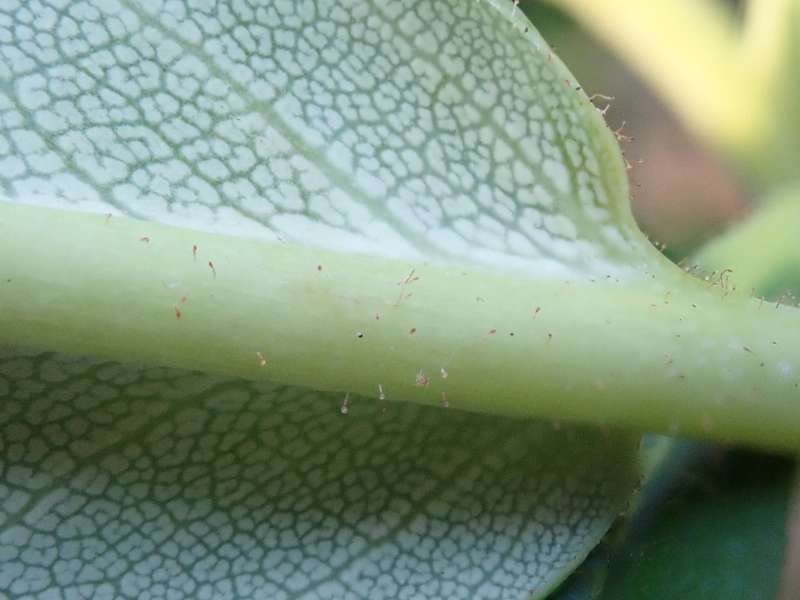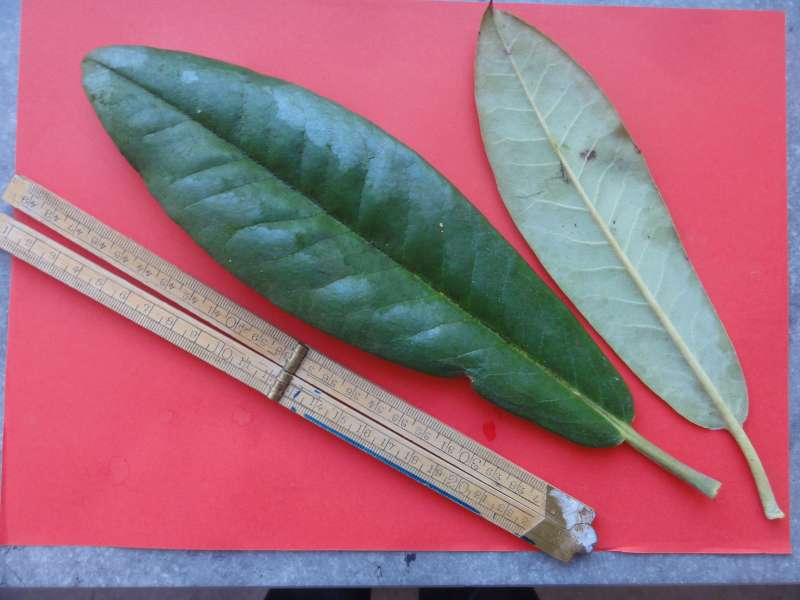Rhododenderon leigongshanense
Billeder af Rhododenderon leigongshanense


Denne plante har dog for mange blomster i klasen end de 10-11. Bladranden med grenede hår.

Beskrivelse
R. leigongshanense (Fortunea) ligner R. glanduliferum, men har stilkede kirtelhår på bladundersiden på unge blade. Vokser i SØ Guizhou. Trompetformede blomster 7,5-8,0 cm long, 8-10 cm in diameter) der sidder 10-11 i blomsterstanden, Frøkapslerne meget rillede og stærkt behårede af langstilkede kirtelhår.
Denne art, R. glanduliferum, R. chihsinanum og R. magniflorum har mange fælletræk og er måske samme art.
R. magniflorum‘s blomst er størst på 9,5-10 cm lang, leigongshanense på 7,5-8 cm og R. glanduliferum på 5-6 cm. lang.
R. magniflorum‘s calyx og blomst har også 7 lober (5 er en fejl), som de tre andre arter
R. chihsinanum har ikke kirtelhåret blomsterstilk, der er 1 cm lang, kronen 4 cm med 7 lober.
Hans Eiberg
● R. glanduliferum frø. SHH. Foto: Hans Eiberg
Artikel; CHENG-HUA YANG, ZHENG-GUO XIE1, YONG-FU YU1 AND ZHI-RONG YANG
Evergreen small tree, 5 m tall, c. 16 cm in diameter; branchlets thick, cylindrical with stipitate glands. Leaf blade leathery or thick-leathery, 6–9 leaves on branch-top, pendulous; young leaves violet, densely stipitate glands and floccose; leaf blade oblong-elliptic, apex acute, base broadly cuneate, slightly asymmetry, 15–21 × 5.0–7.5 cm, margin revolute, abaxial surface stipitate
glands; midrib, veins and lateral veins slightly grooved adaxially, midrib and lateral veins prominent abaxially, lateral veins 15–18 pairs. Petiole 2–4 cm long, glandular. Inflorescence racemose, 10 or 11-flowered, rachis light brown, 7.0–9.5 cm long, densely stipitate glands; bract
lanceolate, abaxial thinly stipitate or non-stipitate glands, adaxial densily glands and villous; pedicels 3.5–4.5 cm long with densely long glands. Calyx 7-lobed, lobes semi-circle, disparate, 2–4 mm long, abaxial glandular, adaxial smooth. Corolla trumpet-shaped, 7-lobed, white, 7.5–8.0 × 8.0–10.0 cm, succulent, aromatic, rotund, abaxial stipitate or non-stipitate glands. Stamens 16, unequal, 4–6 cm long, filaments bald. Ovary conoid, 5–8 mm long, densely glands; style thick, 5–
8 cm long, faint green, densely stipitate or non-stipitate glands to the tip; stigma pale, disk-like, 2–3 mm in diameter. Capsule cylindric, 3.0–3.5 × 1.0–1.2 cm, slightly curved, densely stipitate or non-stipitate glands.
Phenology: Flowering from June to July; fruiting from October to November.
Etymology: The specific epithet is named after the type locality Leigongshan. Vernacular name: Leigongshan Dujuan.
Distribution: So far, this species is only known from the type locality Leigongshan Nature Reserve, Leishan County, Guizhou Province, southwest China.
Habitat: This species grows in evergreen broad-leaved forests on limestone hills at 1,400 m. IUCN Red List category: Since only one population and a total of 50 mature individuals of this species were found in the area from where the type collections were made, the species seems to be very rare and restricted in distribution. A preliminary conservation assessment for the species
gave it Critically Endangered (CR) status, based on criterion D (population less than 50 mature individuals) of the IUCN Red List criteria (IUCN, 2011). Therefore, careful protection of the species is warranted.
R. leigognshanense
R. leigognshanense has only been introduced once – CDHM#14658 which I mistakenly sold as glanduliferum as we were well within the possible range of that species and it looked very similar. I had not realized that botanists in China had recently named it as a new species. It is separated from glanduliferum by having stipitate glands on the lower surface of the leaf and is currently known only from the mountain Leigong Shan in east-central Guizhou. I have not flowered it yet but am assuming it is within the glanduliferum/magniflorum complex. The “true” glanduliferum from NE Yunnan (the type location) is under my number SEH#174 and has really big leaves and flowers in late summer. The PW collections from N Guizhou (which he collected under many names) have smaller leaves and flower in mid June with us.
Recently there was a bit of correspondence with folks in the UK trying to sort out all the PW#s from his 1994 trip. Lots of confusion as many of you know. I went through all of it at the RSF that we have grown and put the corrrect names on things. I can send this attachment to the group this evening. We have learned a great deal about the rhodos from that area since then (but still really confused in many ways!). Hope that will clear things up a bit for some folks.
Steve Hootman











